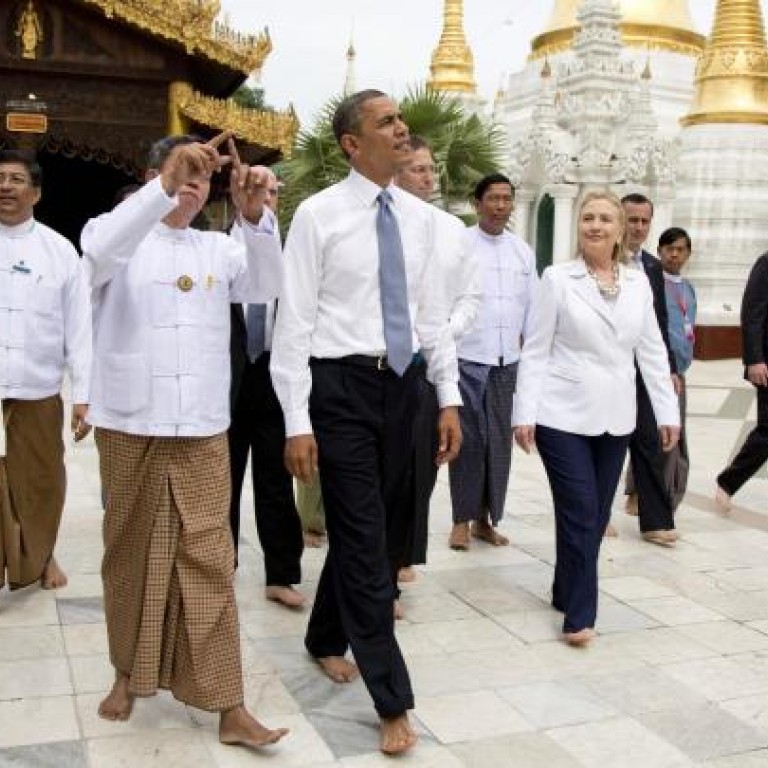
Bridge over the Pacific
The Obama administration aims to capitalise on future Asian economic growth amid fears that China's rise might be a threat to the region
More than a century and a half after Millard Fillmore dispatched an emissary to Asia to transform commerce across the Pacific, a US president again sees an historic opportunity to strengthen America's role in the region.

As in the wake of US Commodore Matthew Perry's 1850s voyages to Japan, American companies are seeking greater opportunities, with General Electric and Ford Motor backing Obama's plan for an 11-country Pacific trade deal that could bring in US$108 billion a year. Instead of Perry's gunships, what may propel Asian nations towards Obama's vision is concern from Japan to Vietnam that China's ascendance may pose a threat.
"The US is serious about its commitment to Asia and sees Asia as the future in terms of economic growth in the 21st century," said Simon Kahn, chairman of the American Chamber of Commerce in Singapore and Google's chief Asia-Pacific marketing officer. "That has a very real impact in discussions with business counterparts in terms of thinking about long-term investments."
The connection is part personal for Obama, 51, who lived in Jakarta from 1967 to 1971. In his second year in office, the president returned to Indonesia's capital, addressing an audience of about 6,000 at the University of Indonesia, highlighting prospects for deeper economic ties, "because a rising middle class here means new markets for our goods, just as America is a market for yours".
Less than two years after that visit, Boeing confirmed a record 230-plane order valued at US$22.4 billion at list prices from Indonesian budget carrier Lion Mentari Airlines.
"If you look at global growth, obviously this region is where the action is," Bill Ford, executive chairman of the second-biggest US carmaker, said during a visit to Thailand, where he toured a US$450 million plant that the company opened this year. The administration's support for US manufacturers had helped Ford expand its exports of the Explorer sport-utility vehicle to more than 90 nations, he said. The IMF forecasts developing countries in Asia to grow 7.7 per cent in 2017, almost triple the pace of advanced economies, boosting demand for everything from toothpaste and cars to missile systems.
Asian stocks also demonstrate the region's lure, with the MSCI Asia Pacific Excluding Japan Index climbing 100 per cent since Obama took office, a period when the MSCI World Index rose 56 per cent. Price-earnings ratios present "no obstacle" to more gains, according to Nomura equity strategists led by Michael Kurtz in Hong Kong. Kurtz's team targeted 530 for the MSCI Asia Pacific Excluding Japan Index in 2013, marking a 14 per cent gain from present levels.
Obama's trade strategy is built around the Trans-Pacific Partnership. Negotiators from 11 countries - Australia, Brunei, Canada, Chile, Malaysia, Mexico, New Zealand, Peru, Singapore, the US and Vietnam - will meet in Singapore in early March for the 16th round of talks aimed at bringing down tariffs, strengthening patent protection and allowing greater access to government contracts. "There are significant risks to the US of being marginalised in Asia if they do not step up to the trade plate," said Deborah Elms, head of the Temasek Foundation Centre for Trade and Negotiations in Singapore. "They have to be able to push the TPP past the finish line."
Japan, South Korea, Thailand and the Philippines are all considering joining the TPP talks - a move that, along with an entry by Indonesia and 11 mostly smaller nations, could bring the US annual income of US$108 billion a year, according to Asia-Pacific Trade, a website whose contributors include Peter Petri, a Brandeis University professor.
The US aims to complete the TPP talks by the end of next year and have it take effect by 2015, said Michael Froman, the deputy national security adviser for international economic affairs.
